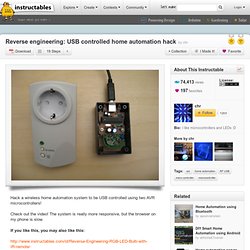

Decoding RF link using a PC soundcard. Reverse engineering radio controlled outlets. Interface with Remote Power Sockets â Final Version « RAYSHOBBY.NET. In previous blog posts, I’ve described two ways to use an Arduino to interface with an off-the-shelf remote power sockets / switches.

The first method uses transistors to simulate button presses. It involves some soldering and hacking the remote control unit. The second method uses an oscilloscope to sniff the signal sent by the remote control, and then simulates the same signal using an RF transmitter. But what if you don’t have an oscilloscope, or don’t know where to place the probe to take the measurement? In this post, I will describe a very simple method to sniff remote control signals. To get started, I picked a set of indoor wireless power sockets from Amazon. RF Sniffing Circuit Ok, here is the fun part: how can we sniff the signals sent by the remote control to the sockets?
This is by no means a new idea. The picture on the left is my implementation of the circuit. Record the Control Signals I used the open-source Audacity software in Linux to record the signals. Download. Shop. Reverse engineering: USB controlled home automation hack. There are two ways of hacking an RF remote to be controlled by a computer or a microcontroller.

The lame way: Soldering wires onto the button pads on the remote and hooking them up to an Arduino. The cool way: Most RF remotes have a separate module for transmitting data. This device usually has a VCC and a GND line and a DATA line. You can easily transmit your own wireless data by connecting a microcontroller to the DATA line. However, in order to transmit something that the wireless receivers can understand, you first have to figure out how the wireless data is formatted and transmitted. To do this hack you will need a logic analyzer and optionally an oscilloscope.
I use the Logic from Saleae. Check it out at It costs 149 USD but it's a good investment for any hacker! You also need to be familiar and comfortable with microcontrollers and programming in C. Rc-switch - Arduino library to operate low cost 315 MHz / 433 MHz remote control devices. There is a port available for Rasperry Pi: Send RC codes Use your Arduino to operate remote radio controlled devices.

This will most likely work with all popular low cost power outlet sockets. All you need is a Arduino, a 315/433MHz AM transmitter (find out where to get one or hack your existing remote control) and one or more devices with a SC5262 / SC5272, HX2262 / HX2272, PT2262 / PT2272, EV1527, RT1527, FP1527 or HS1527 chipset. Also supports Intertechno outlets. Receive and decode RC codes Find out what codes your remote is sending.
All you need is a Arduino, a 315/433MHz AM receiver (altough there is no instruction yet, yes it is possible to hack an existing device) and a remote hand set. Contact (Ich spreche übrigens primär deutsch, but you can also write in english :) mailto: s (at) sui (dot) li. Interface with Remote Power Sockets. Getting an Arduino to control a wireless outlet.